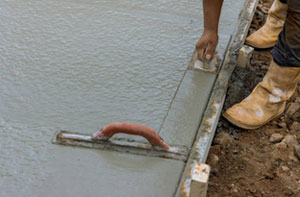What is Screeding?
Delving into the World of Screeding and Floor Screeds
In the realm of construction, screeding plays a crucial role in transforming rough, uneven surfaces into smooth, level foundations for flooring, paving, and other essential elements. But what exactly is screeding? Dive deeper with us as we explore its intricacies, applications, and various forms, providing a comprehensive understanding, and answering the common question "what is screeding?":

The Essence of Screeding: A Layered Foundation
At its core, screeding is the process of applying a thin layer of material over a subfloor or base to create a flat, level surface. This "thin layer" can be composed of various materials, each with its own advantages and suitability for specific purposes. The thickness of the screed typically ranges from 15mm to 50mm, depending on the application and requirements.
Beyond Flatness: The Functional Role of Screeds
While achieving a smooth, level surface is the primary objective, screeding offers several advantages:
- Strength and Stability: It reinforces the subfloor, enhancing its load-bearing capacity and preventing cracking or movement.
- Improved Insulation: Certain screeds offer thermal insulation, contributing to energy efficiency.
- Moisture Protection: Waterproof or damp-proof screeds act as a barrier against moisture ingress, protecting underlying structures.
- Preparation for Flooring: It creates a perfect base for various floor finishes like tiles, carpets, and wood, ensuring evenness and preventing damage.
- Concealing Services: Pipes and cables can be embedded within the screed, providing a clean and streamlined finish.
A Versatile Material: Exploring Different Types of Screed
The versatility of screed lies in its diverse material options, each with unique properties:
1. Sand and Cement Screed: This traditional screed blends cement, sharp sand, and water, offering affordability and durability. However, it requires drying time and is susceptible to cracking.
2. Liquid Screed: This self-levelling, faster-drying option provides a smooth finish and reduced drying time, making it ideal for tight timelines. However, it requires specialist expertise and can be more expensive.
3. Anhydrite Screed: This flowable screed dries quickly and offers good thermal insulation, but requires specialist mixing and may need additional moisture barriers.
4. Calcium Sulphate Screed: Similar to anhydrite, it offers fast drying and good insulation, but is less widely available and may have higher costs.
5. Bonded Screed: Thin and directly bonded to the subfloor, this screed is space-saving and ideal for uneven surfaces. However, it requires a strong subfloor and may not be suitable for high-moisture environments.
6. Unbonded Screed: Separated from the subfloor by a damp-proof membrane, this screed provides insulation and moisture protection, but requires additional height allowance.
7. Floating Screed: Laid on a thermal and sound insulation layer, this screed offers excellent insulation and soundproofing, but adds thickness to the floor.
Choosing the Right Screed: Matching Needs with Options
Selecting the appropriate screed requires considering several factors:
- Substrate Type: The existing subfloor material and condition heavily influence the suitable screed type.
- Purpose and Use: The intended use of the finished floor space, such as high-traffic areas or bathrooms, affects material selection.
- Thickness Requirements: Consider available room height and required finished floor level.
- Drying Time: Project timelines and occupancy needs can influence the choice between faster-drying options like liquid screed.
- Budget: Different screed materials and installation methods vary in cost, impacting your budget allocation.
Beyond the Basics: The Art of Screeding
While screeding may seem straightforward, it demands meticulousness and expertise for a successful outcome. Skilled screeders ensure:
- Proper subfloor preparation: Cleaning, levelling, and priming the subfloor is crucial for optimal adhesion and performance.
- Accurate mixing and application: Precise ratios and controlled pouring techniques are essential for achieving the desired consistency and thickness.
- Levelling and finishing: Utilizing screed guides, trowels, and other tools ensure a perfectly flat and smooth surface.
- Curing and protection: Following proper curing procedures and protecting the screed from damage during drying are vital for optimal strength and durability.
The Enduring Value of Screeding: A Foundation for Success
Whether embarking on a renovation project or constructing a new building, understanding the role and intricacies of screeding empowers you to make informed decisions. By appreciating its functional benefits, diverse material options, and proper application practices, you can ensure a secure, level, and durable foundation for your dream space.
This exploration of screeding hopefully sheds light on its importance and provides valuable insights for homeowners. It was written to answer the question "What is Screeding?".

